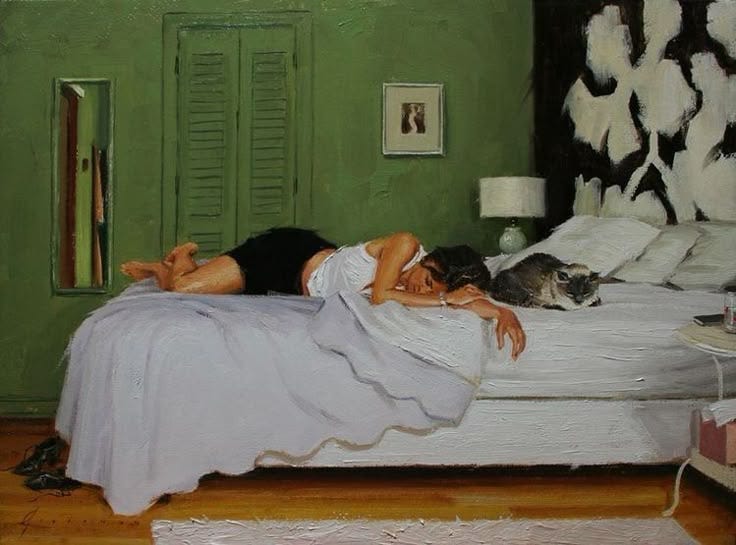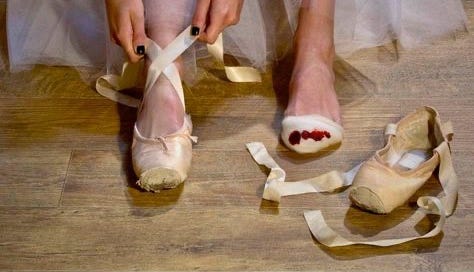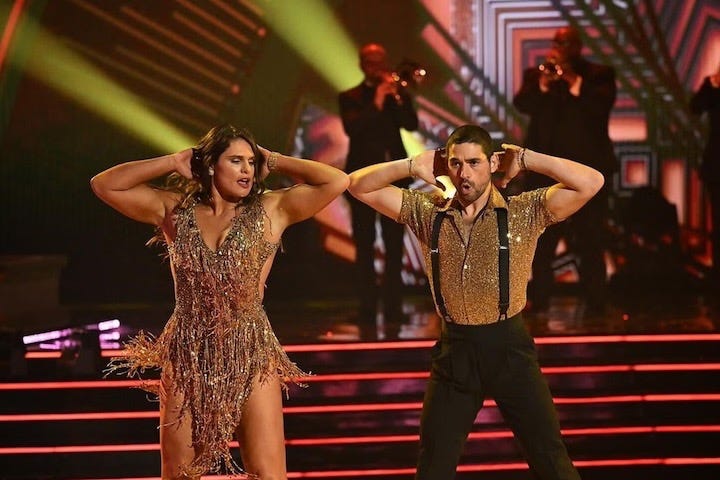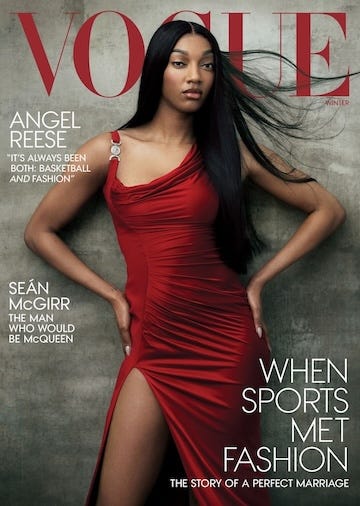A few months ago, I took my first ballet class after an eight year break. I expected to be rusty, but fighting for my life to synchronize my limbs and gassing out after basic jetés - skills I took for granted at age 8 - was humbling to say the least. The Washington Ballet had an interesting crowd - average age was 38 with a high standard deviation. The mirrored room in Cathedral Heights had retired dancers in their 60s, non-professional ballerinas in Nike shorts who, after years of training, took classes as a hobby, and then there were a few women in their late 20s and early 30s, dressed head-to-toe in the lightest shade of pink possible, hair heat-styled, wearing countless bows.
I know this sounds like internalized misogyny has eaten me alive, but hear me out…
Dance is a sport - it’s sweaty, requires cross-training, and can be physically painful (TMI: to this day, my toenails break in half regularly even though I haven’t been on pointe in almost a decade). It looks feminine, but the work required for ballet to look delicate is quite the opposite of feminine. The Ballet Core aesthetic, just like the Pilates Princess, irks me not because it’s hyper-feminine, but because it is inconvenient and restrictive.
The Ballet Core and Pilates Princess aesthetics have taken over the internet for a few months now. Their rise in popularity is not surprising, as they gained traction alongside other ultra feminine trends: soft-core, coquette, “girl-math”, and then of course, there's Sabrina Carpenter. My gripes include, but are not limited, to the following:
Softcore was an anti-capitalist movement, then someone found a way to capitalize on it: Before it was pastel colors, Reformer Pilates, and sundresses, softcore was a movement of radical rest. Gen Z Nigerian women originated the softcore trend to counter the strong black women trope, encouraging rest and slow living. Ironically, Americans re-shaped this anti-capitalist, feminist movement to encompass TikTok aesthetic videos that capitalize on our attention and $45+ Pilates classes (soft! remember: low-impact workouts lower your cortisol. Add high cortisol to the list of irrational health concerns!).
The disservice of Girl Math: We told society that we are incapable of managing our own finances. Friendly reminder: Women have been able to open a bank account in the states for 51 years. Currency has existed for 5,000 years.
Miss Short n’ Sweet: She released some bangers and from a marketing perspective, her brand is strategic and genius. But there is something eerie about the 1950s elements of her persona, and what’s even more eerie is her market’s affinity to it (if you want to dive into this rabbit hole, read: your fave is selling a pedophilic fantasy).
I understand the appeal of these trends - living in a world of hyperproductivity and meritocracy where there isn't really an opportunity to slow down, reconnecting with girlhood not only validates our stress, but it can also feel sheltering. Little treat culture can help us cope with the idea that we might never be homeowners. However, with the current presidential term, the harm caused by the helplessness associated with girlhood outweighs any positives girlhood’s escapism might provide. You are not just a girl, you’re a grown ass person.

The Pilates Princess aesthetic has problems of its own. Pilates has been popular in mainstream media for decades. It has always had the It Girl allure - think Samantha Jones. Mikaela Johnson brilliantly described doing pilates as shorthand for hot woman. However, like ballet, Pilates is a sport.
Joseph Pilates developed Pilates, initially called Contrology, while interned in a camp during World War I, where he devised apparatuses to help injured and disabled war prisoners. He then emigrated from Germany to New York and opened a studio that was popularized by socialites and dancers. Pilates is amazing for strengthening the mind-body connection, developing breath awareness, and strengthening core and spine alignment. But that is not what the Pilates Princess aesthetic markets.

Pilates is not actually effective for weight loss, despite Before-and-After Pilates body TikTok videos have upward of 200K likes. The problem with the Pilates Industrial Complex, according to Johnson, is that it can scam women out of a lot of money, as well as out of exercises that will better suit their health and fitness goals. The idea that low-impact yet expensive workouts like Pilates are not practical for helping women achieve the lean physique which it markets is not novel (and actually extensively written about), but it’s in capitalism’s best interests to believe the myth.
The desire for Pilates arms, or ballerina body, can be considered the natural response to Ozempic and other GLP-1 drugs becoming increasingly accessible. The Snob Effect is an economic theory that explains consumer behavior of luxury products (and in this economy, 50 minutes in a reformer is a luxury). Snob consumers will spend their money on products and services that are an indicator of privilege, but they will avoid choosing the popular brand as they want to be separated from non-elite consumers by having what others cannot. In this case, snob consumers will spend their money on thinness, the luxury good, but they will not choose the mainstream brand of thinness, that which is the byproduct of weight-loss drugs. Instead, snob consumers want the thinness that the working class cannot access: the toned, lean physique that is falsely marketed as “the byproduct of biweekly Pilates classes", but is actually the result of genetics, a gym membership, a dietician, and hundreds of Pilates classes. In response to the working class having access to conventional thinness, the beauty standard is changing towards the harder to achieve toned, lean physique.
Johnson argues weightlifting, which women have been conditioned to believe is for men and will not help them achieve their personal goals, could prevent women from getting hustled from achieving their fitness goals. However, disproving the misconception that weightlifting makes women bulky has been ineffective for decades. This cultural shift requires more radical change: western society needs to debunk the idea that athleticism and femininity are mutually exclusive.
Female athletes have always been cool, but the majority of American women have never wanted to be them. Last year, the Paris Olympics and the release of Challengers provided female athletes with more opportunities to showcase their femininity in mainstream media. Olympic rugby player Ilona Maher placed second on Season 33 of Dancing with the Stars, standing out for her charismatic personality as she stated she competed to facilitate body acceptance among young viewers.
A few months later, Angel Reese landed the cover of American Vogue, showcasing the intersection of fashion and sport. Women’s sports provides a glimpse of hope in a world obsessed with the female body. Compared to boutique fitness, sports is a form of physical activity that shifts partial focus away from physical aesthetics and instead towards competition, building community, and encouraging leadership. Despite this, by age 14 girls are twice as likely dropout of sports than boys.
What if all the pieces lined up?
With our media consumption habits now being more traceable than ever, engaging with female athletes on social media platforms can increase their access to major brand deals. Their increased partnership opportunities, shifting from primary sports brands to major fashion brands, and media presence could change the beauty standard, away from the already decreasing demand for thinness and further towards toned (hey, maybe even towards muscular!!) A girl can only hope.
editor creds: Lizzie Benjamin <3
As promised, post is accompanied with playlist: my (current) favorite sculpt songs. Hope they hype you up!









This is something I’ve thought about a lot about recently trying to make sense of all these trends and “jokes” you mentioned. Internet trends are not isolated from the world around us and are often very concerted social engineering efforts. In the midst of our rights, autonomy, respect for women being stripped away and a general wave of regarding women as parts of their husband, at best or children, at worst. Trends like this seem to encourage women to say “take it all, we barely used it anyway”.
"the harm caused by the helplessness associated with girlhood outweighs any positives girlhood’s escapism might provide" you might be the smartest bitch alive actually